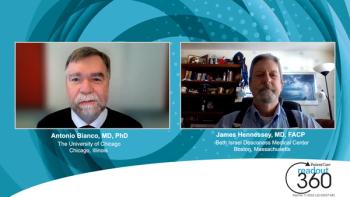
Subclinical Thyroid Disease: When to Treat and How
Treatment for subclinical varieties of thyroid disease is rarely black and white. Here is a brief guide to navigating the grey.
Thyroid over- and under-activity used to be an “all-or-none” category. That is, excess antibodies (Graves disease) or an overactive nodule led to an elevation in thyroid hormones (T4 and T3), suppression of TSH, and the overt clinical signs of hyperthyroidism. On the other side, rising TSH secretion, as a response to decreased thyroid output of T4 and T3, was followed by hypothyroidism. Today we know there is much more to the story, that is, there are subclinical varieties of both hypo- and hyperthyroidism. They are defined as follows:
Subclinical hypothyroidism is an elevated TSH value (on at least 2 occasions) with normal thyroid (T4) hormone levels.
Subclinical hyperthyroidism, conversely, is characterized by a repeatedly decreased TSH with normal thyroid hormone values.
Within the spectrum of subclinical thyroid function there are important questions to ask: should treatment be initiated? If the answer is yes, when and what hormone should be utilized? Do many patients with a subclinical diagnosis progress to clinical hypo- and hyperthyroidism? If left untreated, do patients incur other risks (eg, elevated lipids and an increased cardiovascular risk with subclinical hypothyroidism)?
Who should be screened for thyroid disfunction in the first place?2
⺠All geriatric patients should be screened upon admission to the hospital.
⺠Women ≥ age 50 years who seek medical care should be screened.
⺠Women in high risk groups (those with an autoimmune disease or strong family history of thyroid disease) should be screened starting at 19 years of age.
Some agencies however (US Preventive Health Services Task force or Royal College of Physicians), do not advocate screening.
Subclinical Hypothyroidism
⺠Subclinical hypothyroidism progresses to overt hypothyroidism in 2-5% of cases per year.1
⺠Select populations require treatment for subclinical hypothyroidism: any pregnant woman or a woman contemplating pregnancy; and any patient with subclinical hypothyroidism and a TSH >10mIU/L.1
⺠In patients with subclinical hypothyroidism who have a TSH <10 mIU/L, treatment should be considered in those with infertility, those with a goiter, or individuals with elevated antithyroid peroxidase antibody levels.1
⺠It is prudent to avoid treatment in patients with subclinical hypothyroidism who are older than age 85 years.1
⺠When treatment is indicated, levothyroxine is the replacement hormone of choice.1
⺠Do not over-replace the deficit. Follow the TSH carefully. The result of excessive replacement doses can be atrial fibrillation, osteoporosis, or coronary ischemia.1,3
Subclinical Hyperthyroidism
This is a more difficult subclinical category. For example, if a decision is made to treat the condition, what approach should be used? Surgery is invasive and radioactive iodine aggressive, especially if the manifestations of the subclinical state are not serious. Although antithyroid medications may be used, they, too, have side effects. Furthermore, not all low TSH levels are a consequence of clinical or subclinical thyroid disease (dopamine and glucocorticoid as well euthyroid sick syndrome can do the same thing). Let’s review some important dos and don’ts in this cohort.
There is good quality evidence for certain decisions in these patients:
⺠The rate of progression to frank hyperthyroidism is approximately 1% per year, lower than progression from subclinical hypothyroid disease.4
⺠Patients with subclinical hyperthyroidism and atrial fibrillation should be treated definitively.5
⺠If the TSH in a postmenopausal woman with subclinical hyperthyroidism and osteoporosis is <0.1 mIU/L., treatment is indicated.5
⺠Obviously if there is progression to overt hyperthyroidism on follow up, treatment is definitely indicated.5
What medications are recommended?
There is far less data in this category than with subclinical hypothyroidism.
⺠Antithyroid drugs like methimazole have been used in subclinical hypothyroid patients with tachycardia or left ventricular wall thickness abnormalities.6
⺠Methimazole treatment has been initiated in post-menopausal women with subclinical hyperthyroidism and goiter. Those treated had better preserved bone density than women with subclinical hyperthyroidism not treated with methimazole.7
Newsletter
Enhance your clinical practice with the Patient Care newsletter, offering the latest evidence-based guidelines, diagnostic insights, and treatment strategies for primary care physicians.



























































































































































































































































































